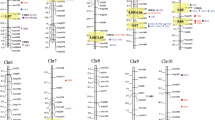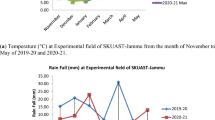Abstract
Nineteen wild emmer wheat [Triticum turgidum ssp. dicoccoides (Körn.) Thell.] genotypes were evaluated for the grain concentrations of phosphorous (P), potassium (K), sulfur (S), magnesium (Mg), calcium (Ca), zinc (Zn), manganese (Mn), iron (Fe) and cooper (Cu) under five different environments in Turkey and Israel. Each mineral nutrient has been investigated for the (1) genotype by environment (G × E) interactions, (2) genotype stability, (3) correlation among minerals and (4) mineral stability. Among the macronutrients analyzed, grain concentrations of Ca (range 338–2,034 mg kg−1) and S (range 0.18–0.43%) showed the largest variation. In the case of micronutrients, the largest variation was observed in the grain Mn concentration (range 13–87 mg kg−1). Grain concentrations of Fe and Zn also showed important variation (range 27–86 and 39–115 mg kg−1, respectively). Accessions with higher nutrient concentrations (especially Zn and Fe) had also greater grain weight, suggesting that higher grain Zn and Fe concentrations are not necessarily related to small grain size or weight. Analysis of variance showed that environment was the most important source of variation for K, S, Ca, Fe, Mn and Zn, explaining between 44 and 78% of the total variation and G × E explained between 20 and 40% of the total variation in all the minerals, except for S and Zn where its effect accounted for less than 16%. Genotype was the most important source of variation for Cu (explaining 38% of the total variation). However, genotype effect was also important for Mg, Mn, Zn and S. Sulfur and Zn showed the largest heritability values (77 and 72%, respectively). Iron exhibited low heritability and high ratio value between the G × E and genotype variance components \( \left( {\sigma_{\text{GE}}^{2} /\sigma_{G}^{2} } \right) \), suggesting that specific adaptation for this mineral could be positively exploited. The wild emmer germplasm tested in the current study revealed some outstanding accessions (such as MM 5/4 and 24-39) in terms of grain Zn and Fe concentrations and environmental stability that can be used as potential donors to enhance grain micronutrient concentrations in wheats.



Similar content being viewed by others
References
Atlin GN, Baker RJ, McRae KB, Lu X (2000) Selection response in subdivided target regions. Crop Sci 40:7–13
Balint AF, Kovacs G, Erdei L, Sutka J (2001) Comparison of the Cu, Zn, Fe, Ca and Mg contents of the grains of wild, ancient and cultivated wheat species. Cereal Res Commun 29:375–382
Bänzinger M, Long J (2000) The potential for increasing the iron and zinc density of maize through plant breeding. Food Nutr Bull 21:397–400
Black RE, Lindsay HA, Bhutta ZA, Caulfield LE, De Onnis M, Ezzati M, Mathers C, Rivera J (2008) Maternal and child undernutrition: global and regional exposures and health consequences. Lancet 371:243–260
Bonfil DJ, Kafkafi U (2000) Wild wheat adaptation in different soil ecosystems as expressed in the mineral concentration of the seeds. Euphytica 114:123–134
Bouis HE (2003) Micronutrient fortification of plants through plant breeding: can it improve nutrition in man at low cost? Proc Nutr Soc 62:403–411
Cakmak I (2000) Role of zinc in protecting plant cells from reactive oxygen species. New Phytol 146:185–205
Cakmak I (2008) Enrichment of cereal grains with zinc: agronomic or genetic biofortification? Plant Soil 302:1–17
Cakmak I, Tolay I, Ozdemir A, Ozkan H, Kling CI (1999) Differences in zinc efficiency among and within diploid, tetraploid and hexaploid wheats. Ann Bot 84:163–171
Cakmak I, Ozkan H, Braun HJ, Welch RM, Romheld V (2000) Zinc and iron concentrations in seeds of wild, primitive and modern wheats. Food Nutr Bull 21:401–403
Cakmak I, Torun A, Millet E, Feldman M, Fahima T, Korol A, Nevo E, Braun HJ, Ozkan H (2004) Triticum dicoccoides: an important genetic resource for increasing zinc and iron concentration in modern cultivated wheat. Soil Sci Plant Nutr 50:1047–1054
Cashman KD (2002) Calcium intake calcium bioavailability and bone health. Br J Nutr 87:169–177
Distelfeld A, Cakmak I, Peleg Z, Ozturk L, Yazici AM, Budak H, Saranga Y, Fahima T (2007) Multiple QTL-effects of wheat Gpc-B1 locus on grain protein and micronutrient concentrations. Physiol Plant 129:635–643
Feldman M (2001) The origin of cultivated wheat. In: Bonjean AP, Angus WJ (eds) The world wheat book. Lavoisier Tech & Doc, Paris, pp 3–56
Finlay KW, Wilkinson GN (1963) The analysis of adaptation in a plant-breeding programme. Aust J Agric Res 14:742–754
Gauch HG (1990) Full and reduced models for yield trials. Theor Appl Genet 80:153–160
Gauch HG (1992) Statistical analysis of regional yield trials: AMMI analysis of factorial designs. Elsevier, Amsterdam
Gauch HG Jr, Zobel RW (1996) AMMI analysis of yield trials. In: Kang MS, Gauch HG (eds) Genotype-by-environment interaction. CRC, Boca Raton, Florida, pp 85–122
Haydon MJ, Cobbett CS (2007) Transporters of ligands for essential metal ions in plants. New Phytol 174:499–506
House WA, Van Campen DR, Welch RM (1996) Influence of dietary sulfur-containing amino acids on the bioavailability to rats of zinc in corn kernels. Nutr Res 16:225–235
Kalayci M, Torun B, Eker S, Aydin M, Ozturk L, Cakmak I (1999) Grain yield, zinc efficiency and zinc concentration of wheat cultivars grown in a zinc-deficient calcareous soil in field and greenhouse. Field Crops Res 63:87–98
Marschner H (1995) Mineral nutrition of higher plants, 2nd edn. Academic, London
McDonald GK, Genc Y, Graham RD (2008) A simple method to evaluate genetic variation in grain zinc concentration by correcting for differences in grain yield. Plant Soil 306:49–55
Miller GD, Jarvis JK, McBean LD (2001) The importance of meeting calcium needs with foods. J Am Coll Nutr 20:168–185
Milligan SB, Balzarini M, White WH (2003) Broad-sense heritabilities, genetic correlations, and selection indices for sugarcane borer resistance and their relation to yield loss. Crop Sci 43:1729–1735
Morgonuov A, Gómez-Becerra HF, Abugalieva A, Dzhunusova M, Yessimbekova M, Muminjanov H, Zelenskiy Y, Ozturk L, Cakmak I (2007) Iron and zinc grain density in common wheat grown in Central Asia. Euphytica 155:193–203
Murphy KM, Reeves PG, Jones SS (2008) Relationship between yield and mineral nutrient concentrations in historical and modern spring wheat cultivars. Euphytica 163:381–390
Nevo E, Korol AB, Beiles A, Fahima T (2002) Evolution of Wild Emmer and wheat improvement: population genetics, genetic resources, and genome organization of wheat’s progenitor, Triticum dicoccoides. Springer, Berlin, Heidelberg, New York
Oikeh SO, Menkir A, Maziya-Dixon B, Welch R, Glahn RP (2003a) Genotypic differences in concentration and bioavailability of kernel-iron in tropical maize genotypes grown under field conditions. J Plant Nutr 26:2307–2319
Oikeh SO, Menkir A, Maziya-Dixon B, Welch R, Glahn RP (2003b) Assessment of concentrations of iron and zinc and bioavailable iron in grains of early-maturing tropical maize genotypes. J Agric Food Chem 51:3688–3694
Oikeh SO, Menkir A, Maziya-Dixon B, Welch R, Glahn RP, Gauch G Jr (2004) Environmental stability of iron and zinc concentrations in grain of elite early-maturing tropical maize genotypes grown under field conditions. J Agric Sci 142:543–551
Ortiz-Monasterio I, Graham RD (2000) Breeding for trace minerals in wheat. Food Nutr Bull 21:392–396
Oury F-X, Leenhardt F, Rémésy C, Chanliaud E, Duperrier B, Balfourier F, Charmet G (2006) Genetic variability and stability of grain magnesium, zinc and iron concentrations in bread wheat. Eur J Agron 25:177–185
Ozturk L, Yazici MA, Yucel C, Torun A, Cekic C, Bagci A, Ozkan H, Braun H-J, Sayers Z, Cakmak I (2006) Concentration and localization of zinc during seed development and germination in wheat. Physiol Plant 128:144–152
Peleg Z, Saranga Y, Yazici A, Fahima T, Ozturk L, Cakmak I (2008) Grain zinc, iron and protein concentrations and zinc-efficiency in wild emmer wheat under contrasting irrigation regimes. Plant Soil 306:57–67
Peterson CJ, Johnson VA, Mattern PJ (1986) Influence of cultivar and environment on mineral and protein concentrations of wheat flour, bran, and grain. Cereal Chem 63:183–186
Rengel Z, Batten GD, Crowley DE (1999) Agronomic approaches for improving the micronutrient density in edible portions of field crops. Field Crops Res 60:27–40
Shi R, Li H, Tong Y, Jing R, Zhang F, Zou C (2008) Identification of quantitative trait locus of zinc and phosphorus density in wheat (Triticum aestivum L.) grain. Plant Soil 306:95–104
Silver NC, Dunlap WP (1987) Averaging correlation coefficients: should Fisher’s z transformation be used? J Appl Psychol 72:146–148
Steadman KJ, Burgoon MS, Lewis BA, Edwardson SE, Obendorf RL (2001) Buckwheat seed milling fractions: description, macronutrient composition, and dietary fiber. J Cereal Sci 33:271–278
Takahashi M, Terada Y, Nakai I, Nakanishi H, Yoshimura E, Mori S, Nishizawa NK (2003) Role of nicotianamine in the intracellular delivery of metals and plant reproductive development. Plant Cell 15:1263–1280
Wangemann M, Selzer A, Leitzmann C, Golf S, Graef V, Katz N (1995) Recommendations on the dietary allowance of magnesium. Magnes Bull 17:79–85
Acknowledgments
Authors are grateful to HarvestPlus biofortification challenge program (www.harvestplus.org) for the financial support. This work has received also support from the State Planning Organization of the Turkish Republic and The Israel Science Foundation grant #1089/04.
Author information
Authors and Affiliations
Corresponding author
Rights and permissions
About this article
Cite this article
Gomez-Becerra, H.F., Yazici, A., Ozturk, L. et al. Genetic variation and environmental stability of grain mineral nutrient concentrations in Triticum dicoccoides under five environments. Euphytica 171, 39–52 (2010). https://doi.org/10.1007/s10681-009-9987-3
Received:
Accepted:
Published:
Issue Date:
DOI: https://doi.org/10.1007/s10681-009-9987-3




